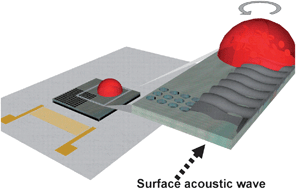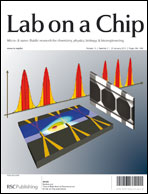The development of microfluidic systems is often constrained both by difficulties associated with the chip interconnection to other instruments and by limitations imposed by the mechanisms that can enable fluid movement and processing. Surface acoustic wave (SAW) devices have shown promise in allowing samples to be manipulated, although designing complex fluid operations involves using multiple electrode transducers. We now demonstrate a simple interface between a piezoelectric SAW device and a disposable microfluidic chip, patterned with phononic structures to control the acoustic wave propagation. The surface wave is coupled from the piezoelectric substrate into the disposable chip where it interacts with the phononic lattice. By implementing both a phononic filter and an acoustic waveguide, we illustrate the potential of the technique by demonstrating microcentrifugation for particle and cell concentration in microlitre droplets. We show for the first time that the interaction of the fluid within this metamaterial phononic lattice is dependent upon the frequency of the acoustic wave, providing a route to programme complex fluidic functions into a microchip (in much the same way, by analogy, that a holographic element would change the phase of a light wave in optical tweezers). A practical realisation of this involves the centrifugation of blood on the chip.

You have access to this article
 Please wait while we load your content...
Something went wrong. Try again?
Please wait while we load your content...
Something went wrong. Try again?


 Please wait while we load your content...
Please wait while we load your content...